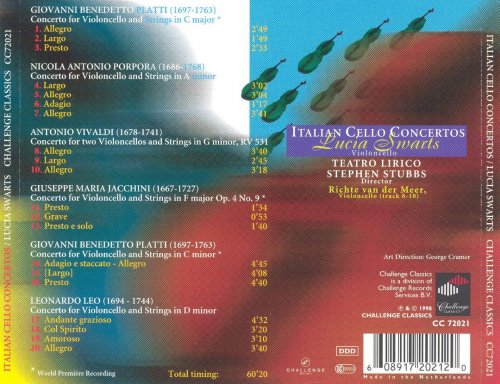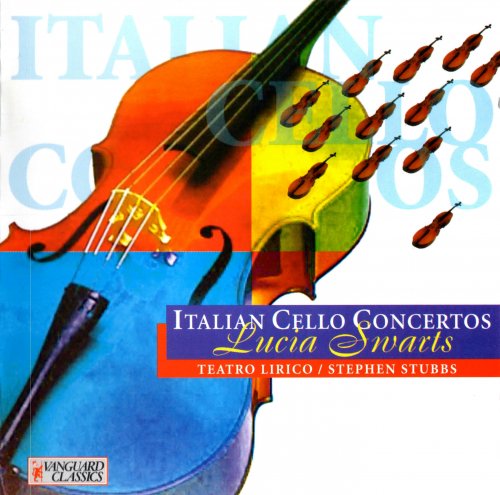
Lucia Swarts - Italian Cello Concertos (1998/2006)
BAND/ARTIST: Lucia Swarts, Stephen Stubbs, Teatro Lirico
- Title: Italian Cello Concertos
- Year Of Release: 1998 / 2006
- Label: Challenge Classics
- Genre: Classical
- Quality: FLAC (image + .cue, log, artwork)
- Total Time: 01:00:10
- Total Size: 312 MB
- WebSite: Album Preview
Tracklist:
Concerto for violoncello and strings in C major
01] Allegro 2:49
02] Largo 1:49
03] Presto 2:33
Concerto for violoncello and strings in a minor
04] Largo 3:02
05] Allegro 3:04
06] Adagio 1:17
07] Allegro 3:41
Double Cello Concerto, for 2 cellos, strings & continuo in G minor, RV 531
08] Allegro 3:40
09] Largo 2:45
10] Allegro 3:18
Concerto for cello & strings in F major Op. 4/9
11] Presto 1:34
12] Grave 0:53
13] Presto e solo 1:40
Concerto for cello & strings in C minor
14] Adagio e staccato - Allegro 4:45
15] [Largo] 4:08
16] Presto 4:40
Cello Concerto in D minor (from 6 Concerti per violoncello), L. 60
17] Andante grazioso 4:32
18] Col Spirito 3:20
19] Amoroso 3:10
20] Allegro 3:40

Concerto for violoncello and strings in C major
01] Allegro 2:49
02] Largo 1:49
03] Presto 2:33
Concerto for violoncello and strings in a minor
04] Largo 3:02
05] Allegro 3:04
06] Adagio 1:17
07] Allegro 3:41
Double Cello Concerto, for 2 cellos, strings & continuo in G minor, RV 531
08] Allegro 3:40
09] Largo 2:45
10] Allegro 3:18
Concerto for cello & strings in F major Op. 4/9
11] Presto 1:34
12] Grave 0:53
13] Presto e solo 1:40
Concerto for cello & strings in C minor
14] Adagio e staccato - Allegro 4:45
15] [Largo] 4:08
16] Presto 4:40
Cello Concerto in D minor (from 6 Concerti per violoncello), L. 60
17] Andante grazioso 4:32
18] Col Spirito 3:20
19] Amoroso 3:10
20] Allegro 3:40

At the beginning of the seventeenth century the violin set out on its march of conquest as a solo instrument. Before then the violin was not thought highly of, but the French theorist Martin Mersenne (1588-1648) called it the king of instruments and praised it for its versatility. It lasted almost a half century before the expressive potential of the (violon)cello, the lyrical tenor and sonorous bass of the same family of instruments, was discovered.
The earliest important solo literature for the cello originated in Bologna in the last decades of the seventeenth century. This northern Italian town was the birth place of and centre of activity for Petronio Franceschini (1651-80), Domenico Gabrielli (1659- 90) and Giuseppe Jacchini (1667-1727), all three of whom were renowned composers and cello virtuosos. Jacchini, Gabrielli’s star pupil, applied himself so well to the cello that he soon was the equal of his teacher. His popularity was increased by his affable personality, described in one eighteenth-century source as “upright” and “straightforward”. In 1689 he was admitted to the orchestra of the municipal church of San Petronio in Bologna. Jacchini was recommended for this position by Count Pirro Albergati, to whom he was to dedicate his opus 4, the Concerti per camera à 3 e 4, twelve years later. This work, which appeared under the imprint of the Bolognese publisher Marino Silvani, is made up of ten short concertos, of which six contain an important solo part for the cello. The ninth concerto of the collection is particularly distinguished for its virtuoso solo part and some attractive dialogues between the cello and the first violin. Jacchini’s harmonic vocabulary is somewhat limited and this is undoubtedly one of the reasons why the three movements are rather loosely constructed.
The earliest important solo literature for the cello originated in Bologna in the last decades of the seventeenth century. This northern Italian town was the birth place of and centre of activity for Petronio Franceschini (1651-80), Domenico Gabrielli (1659- 90) and Giuseppe Jacchini (1667-1727), all three of whom were renowned composers and cello virtuosos. Jacchini, Gabrielli’s star pupil, applied himself so well to the cello that he soon was the equal of his teacher. His popularity was increased by his affable personality, described in one eighteenth-century source as “upright” and “straightforward”. In 1689 he was admitted to the orchestra of the municipal church of San Petronio in Bologna. Jacchini was recommended for this position by Count Pirro Albergati, to whom he was to dedicate his opus 4, the Concerti per camera à 3 e 4, twelve years later. This work, which appeared under the imprint of the Bolognese publisher Marino Silvani, is made up of ten short concertos, of which six contain an important solo part for the cello. The ninth concerto of the collection is particularly distinguished for its virtuoso solo part and some attractive dialogues between the cello and the first violin. Jacchini’s harmonic vocabulary is somewhat limited and this is undoubtedly one of the reasons why the three movements are rather loosely constructed.
Classical | FLAC / APE | CD-Rip
As a ISRA.CLOUD's PREMIUM member you will have the following benefits:
- Unlimited high speed downloads
- Download directly without waiting time
- Unlimited parallel downloads
- Support for download accelerators
- No advertising
- Resume broken downloads


